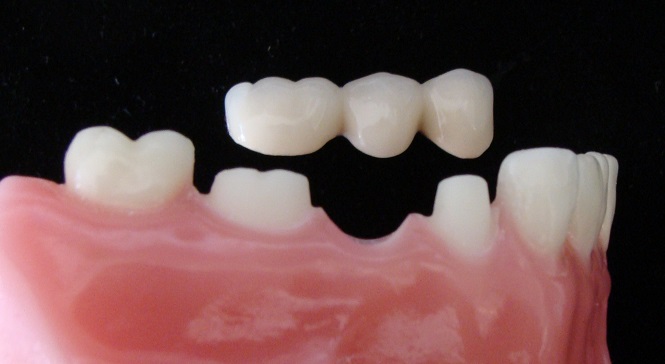A bridge, like an implant, can be seen as a fixed prosthesis that replaces one or more missing teeth. The bridge is attached to the surrounding teeth, and unlike an implant, the treatment does not require jaw surgery. Instead, the bridge is secured around the remaining adjacent teeth using a dental cement. The bridge cannot be removed and will feel very similar to natural teeth. Since it is fixed and shaped like natural teeth, it provides a natural feel and the same good chewing function as real teeth.
To create a bridge, it is necessary to grind around the teeth that will serve as bridge abutments. This can often unnecessarily strain these teeth, and in such cases, treatment with implants may be recommended instead. However, there will be situations where a bridge is the obvious choice. This is typically the case when the teeth in question already require significant treatment. If the teeth have undergone root canal treatment or extensive repairs with fillings, it is natural to recommend crowns for these teeth. In such cases, a bridge can be a good and sensible treatment option.
A dental bridge consists of bridge abutments and pontics. The pontic is located between the natural teeth where teeth are missing. The bridge abutments are the teeth that support the bridge. Depending on the number of missing teeth, there may be two or more bridge abutments. Therefore, a dental bridge will always consist of a minimum of 3 contiguous teeth, two bridge abutments, and a pontic. However, bridges can be made with up to 16 pontics if an entire upper or lower jaw requires treatment.
In order to place the bridge on the teeth, the bridge abutments are prepared and impressions of the bridge abutments and remaining teeth are taken. At the same appointment, temporary caps are made for the prepared teeth. Sometimes it is possible to make a temporary bridge out of plastic material at this stage.
Subsequently, the final bridge is fabricated by a dental technician, and a couple of weeks after the initial consultation, the new bridge is cemented onto the teeth.
A dental bridge can be made to perfectly mimic the appearance of your own teeth. The technique for making a bridge is the same as for crowns and implants as they are typically made of porcelain. In contrast, removable dentures, where the teeth are typically made of plastic material. Treatment with bridges or implants as a replacement for missing teeth is therefore preferable for aesthetic reasons compared to a denture.

The only absolute argument for a bridge over an implant is medical history. For example, if you have been treated with high doses of bisphosphonate, it will not be possible to place implants. But other medical situations can also exclude or complicate treatment with implants. Therefore, it is very important that you inform us about your medical history during the preliminary examination.
Another argument for choosing a bridge is time. It takes 2 - 3 weeks to get a bridge made, while treatment with implants can easily take 6 - 8 months. If there is a need to replace more than one tooth, a bridge will also be considerably cheaper than treatment with implants. The reason why implants are still recommended in many situations is to reduce the number of teeth involved and thus the number of teeth that need to be repaired if a problem arises at some point. Cleaning around a bridge is also more difficult and time-consuming than with an implant.
If the teeth that are to serve as abutments for the bridge are very worn down and have already undergone extensive treatment, a bridge is a good choice. In these types of situations, crowns are typically recommended for the worn down teeth, and if the crowns can also serve as abutments for the bridge, it is a clear choice.
However, if the adjacent teeth to the missing tooth are intact and healthy, it is best to avoid grinding them down. This is because there is a risk of complications such as nerve inflammation when grinding a tooth. In these cases, implants are typically recommended.
Prior to any treatment, you will be presented with the different options, and together we will find the solution that best suits you.